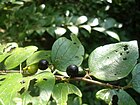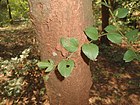Note: This is a project under development. The articles on this wiki are just being initiated and broadly incomplete. You can Help creating new pages.
Difference between revisions of "Ziziphus xylopyra"
| Line 11: | Line 11: | ||
==Common names== | ==Common names== | ||
| − | {{Common names|sa=|en=|gu=|hi=|kn=|ks=|ml=|mr=|pa=|ta=|te=}} | + | {{Common names|sa=|en=Kath Ber|gu=|hi=Kathber|kn=ಗೊಟ್ಟೆ Gotte|ks=|ml=|mr=Ghatbor|pa=|ta=Mulkottai|te=Gotti Chettu}}<ref name="Common names"/> |
==Properties== | ==Properties== | ||
| Line 70: | Line 70: | ||
<ref name="chemical composition">[https://www.farmavita.net/farmavitanet-journal/life-science-files/53-life-science-article/1626-zizyphus-xylopyrus#:~:text=The%20major%20chemical%20composition%20of,4%2Ddiol%20and%20oleanolic%20acid. Chemical constituents]</ref> | <ref name="chemical composition">[https://www.farmavita.net/farmavitanet-journal/life-science-files/53-life-science-article/1626-zizyphus-xylopyrus#:~:text=The%20major%20chemical%20composition%20of,4%2Ddiol%20and%20oleanolic%20acid. Chemical constituents]</ref> | ||
| − | |||
<ref name="Leaf">[Morphology]</ref> | <ref name="Leaf">[Morphology]</ref> | ||
| − | + | <ref name="Common names">[http://www.flowersofindia.net/catalog/slides/Kath%20Ber.html#:~:text=Ziziphus%20xylopyrus%20%2D%20Kath%20Ber&text=Kath%20Ber%20is%20a%20large,blunt%2C%20base%20oblique%2C%20rounded. Common names]</ref> | |
<ref name="How to plant/cultivate">[http://tropical.theferns.info/viewtropical.php?id=Ziziphus+abyssinica Cultivation]</ref> | <ref name="How to plant/cultivate">[http://tropical.theferns.info/viewtropical.php?id=Ziziphus+abyssinica Cultivation]</ref> | ||
<ref name="Uses">Indian Medicinal Plants by C.P.Khare</ref> | <ref name="Uses">Indian Medicinal Plants by C.P.Khare</ref> | ||
Revision as of 16:05, 10 September 2020
Ziziphus abyssinica is a fiercely thorny, semideciduous plant, varying in habit from an erect shrub; a scrambling plant that clambers into other vegetation for support; or a tree with drooping branches that form a heavy, rounded crown. It usually grows from 3 - 12 metres tall. The bole is usually straight. The plant is harvested from the wild as a local source of food, medicines and other materials. It is sometimes cultivated as a stock-proof hedge.
Contents
- 1 Uses
- 2 Parts Used
- 3 Chemical Composition
- 4 Common names
- 5 Properties
- 6 Habit
- 7 Identification
- 8 List of Ayurvedic medicine in which the herb is used
- 9 Where to get the saplings
- 10 Mode of Propagation
- 11 How to plant/cultivate
- 12 Commonly seen growing in areas
- 13 Photo Gallery
- 14 References
- 15 External Links
Uses
Stomachache, Snakebite, Pneumonia.[1]
Parts Used
Chemical Composition
The major chemical composition of Z. xylopyrus are rich in flavonoids in particular quercetin, quercitrin, kaempferol-4’-methylether and kaempferol, tannins (7.2%), d-7, 3’, 4’-trihydroxyflavan-3, 4-diol and oleanolic acid etc.[2]
Common names
| Language | Common name |
|---|---|
| Kannada | ಗೊಟ್ಟೆ Gotte |
| Hindi | Kathber |
| Malayalam | |
| Tamil | Mulkottai |
| Telugu | Gotti Chettu |
| Marathi | Ghatbor |
| Gujarathi | |
| Punjabi | |
| Kashmiri | |
| Sanskrit | |
| English | Kath Ber |
Properties
Reference: Dravya - Substance, Rasa - Taste, Guna - Qualities, Veerya - Potency, Vipaka - Post-digesion effect, Karma - Pharmacological activity, Prabhava - Therepeutics.
Dravya
Rasa
Guna
Veerya
Vipaka
Karma
Prabhava
Habit
Identification
Leaf
| Kind | Shape | Feature |
|---|---|---|
Flower
| Type | Size | Color and composition | Stamen | More information |
|---|---|---|---|---|
| {{{5}}} |
Fruit
| Type | Size | Mass | Appearance | Seeds | More information |
|---|---|---|---|---|---|
Other features
List of Ayurvedic medicine in which the herb is used
Where to get the saplings
Mode of Propagation
How to plant/cultivate
A plant usually of the drier areas of the hot tropics, where it can be found at elevations from 400 - 2,000 metres.[5]
Commonly seen growing in areas
Scattered tree grassland, Combretum-Terminalia woodlands, Acacia woodlands.
Photo Gallery
References
- ↑ Indian Medicinal Plants by C.P.Khare
- ↑ Chemical constituents
- ↑ Common names
- ↑ [Morphology]
- ↑ Cultivation
External Links
- Ayurvedic Herbs known to be helpful to treat Stomachache
- Ayurvedic Herbs known to be helpful to treat Snakebite
- Ayurvedic Herbs known to be helpful to treat Pneumonia
- Herbs with Fruits used in medicine
- Herbs with Leaves used in medicine
- Herbs with common name in Kannada
- Herbs with common name in Hindi
- Herbs with common name in Tamil
- Herbs with common name in Telugu
- Herbs with common name in Marathi
- Herbs with common name in English
- Habit - Semi-deciduous shrub
- Index of Plants which can be propagated by Seeds
- Herbs that are commonly seen in the region of Scattered tree grassland
- Herbs that are commonly seen in the region of Combretum-Terminalia woodlands
- Herbs that are commonly seen in the region of Acacia woodlands
- Herbs






